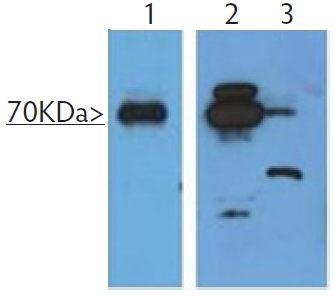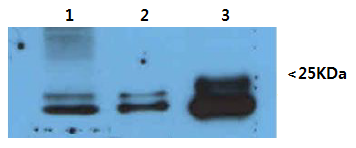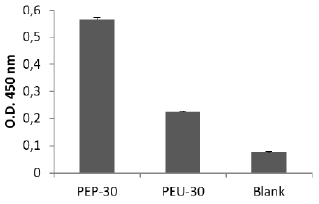Antibodies For Exosome Research
본문
|
Antibodies For Exosome Research
An essential tool for basic research, development of diagnostic tests and therapeutics for human disease. Extracelluar vesicles (EVs), including exosomes, express antigens with 3D conformations and/or post- translational modifications that often differ from the cellular counterpart. For this reason, most of the antibodies currently available on the market fail to recognize exosome-associated antigens with sufficient sensitivity and specificity. In collaboration with Exosomics Siena spa, HBM has validated a list of polyclonal and monoclonal antibodies against common (CD63, CD81, ALIX) and disease- specific (cancer and neurodegenerative diseases) exosomal markers.
Monoclonal antibodies
Anti-CD9 antibodies Anti-CD9 recognizes an human 24-kiloDalton (kDa) single-chain cell-surface glycoprotein (p24) belonging to the tetraspanin family. Cd9 has a very broad tissue distribution and is abundant on exosome membranes. HBM offers two monoclonal anti-CD9 antibodies, unconjugated or biotin conjugated, recognizing the specific antigen on both cell lines and extracellular vesicles. HBM antibodies are compatible with ELISA, WB and flow cytometry applications.
Western blotting ELISA 1-COLO1 cell lysate (20μg) CD9 detection in purified exosomes from 1-CD9 detection in plasma purified (20μg) human plasma(PEP) and urine(PEU) 30μg
Anti-CD63 antibodies Anti-CD63 recognizes an extracelluar fragment of CD63, a 56 kiloDalton (kDa), type III lysosomal glycoprotein, belonging to the tetraspanin family. CD63 is expressed by granulocytes, platelets, T-Cells, monocytes/macrophages and endothelial cells. CD63 protein is a canonical exosome marker and currently used to characterize exosome populations from a variety of body fluids.
Anti-CD41 antibodies lntegrin alpha chain 2b, also known as CD41, is an heterodimeric integral membrane protein. It undergoes post-translational modifications that result in two polypeptide chains linked by a disulfide bond. CD41 is expressed on platelets and megakaryocytes, but also on early embryonic hematopoietic stem cells and related exosomes.
Anti-CD81 antibodies CD81 (TAPA1), a member of the tetraspanin family, is virtually expressed on all nuclated cells, but in particular on germinal center B cells. CD81 forms complexes with other tetraspanin proteins, integrins and coreceptors. CD81 is expressed on exosome membranes.
Western blotting FACS 1- COLO1 cell lysates (20 μg) CD81 staining of COLO1 derived exosomes (30 μg) 2- COLO1 derived exosomes (20 μg) 3- Plasma derived exosomes (20 μg)
Anti-CD44 antibodies CD44, known also as HCAM, is a 742 aminoacids protein involved in lymphocytes activation, homing and hematopoiesis, CD44 is expressed in multiple isoforms. CD44 is highly expressed in cancer tissues and tumoral-derived exosomes, suggesting a role in tumor progression and metastasis.
Anti-CAVEOLIN 1 antibodies The lipid raft-associated protein caveolin-1 (CAV1) is the major component of the inner surface of caveolae, small invaginations of the plasma membrane. Caveolin is a transmembrane adaptor moleculer that can simultaneously recognize GPI-linked proteins and interact with downstream cytoplasmic signaling molecules It is highly expressed on exosomes derived from tumor tissue.
Anti-ALIX antibodies The lipid raft-associated protein caveolin-1 (CAV1) is the major component of the inner surface of caveolae, small invaginations of the plasma membrane. Caveolin is a transmembrane adaptor molecule that can simultaneoulsy recognize GPI-linked proteins and interact with downstream cytoplasmic signaling molecules. It is highly expressed on exosomes dervied from tumor tissue.
Anti-TM9SF4 antibodies TM9SF4 (TUCAP1) is a newly discovered tumor-associated protein of unknown function that belongs to the Trans-Membrane 9 Superfamily (TM9SF). These proteins are characterized by the presence of a large variable extracellular N-terminal domain followed by nine putative transmembrane domains and a conserved C-terminal domain. TM9SF4 is mainly expressed on exosomes derived from tumor tissue. HBM offers three different monoclonal antibodies that recognize the protein on both exosomes and cell lysates.
Polyclonal Antibodies
Anti-Flotillin antibodies Flotillin belongs to the band 7.2/stomatin protein family and appears to be strongly expressed in muscle cells and fibroblasts. Flotillin expression is also correlated with Alzheimer development. Flotillin is highly expressed on exosomes and appears to be involved in exosome release.
ELISA FACS Detection of different exosomes purified from cell Purified exosomes from MM1 (30 μg) culture supernatants or human plasma (HD), perfomed stained by anti-Flotillin antibody with anfi-Flotilin
Anti-RAB5 antibodies Rab5 is a small GTPase belonging to Ras superfamily of monomeric G-proteins. RabGTPases play an essential role in the regulation of membrane traffic and are involved in vesicle formation and transport and fusion to the membrane. Rab5 is expressed on exosome membranes and it have might an active role during endo/exocytotic processes of microvesicles through the plasma membrane.
Anti-HSP70 antibodies Heat shock protein 70 (HSP70) is a molecular chaperone that facilitates the assembly of multi-protein complexes and trafficking of polypeptides across cell membranes. HSP70 is active in promoting tumorigenesis and functions as an anti-apoptotic factor. It is highly expressed on exosomes derived from tumor tissues.
Anti-TM9SF3 antibodies TM9SF3 belong to nonaspanins family proteins (TM9SF), characterized by a large non-cytoplasmic domain and nine putative transmembrane domains. Although little is known about the function/s of this protein, it might participate in tumor invasion and it is emerging as a potential prognostic factor. Protein is expressed on plasma membranes and exosomes.
Anti-TM9SF4 antibodies TM9SF4 (TUCAP1) is a newly discovered tumor associated protein that belongs to the Trans-Membrane 9 Superfamily (TM9SF). These proteins are characterized by the presence of a large variable extracelluar N-terminal domain followed by nine putative transmembrane domains and a conserved C-termianl domain. TM9SF4 is mainly expressed on exosomes derived from tumor tissue. HBM offers three rabbit polyclonal antibodies that recognize the protein from both exosomes and cell lysates.  Western blotting Detection of TM9SF4 in: 20 μg of whole HEK293 cell lysaye (1), 20 μg of exosomes purified from MM1 cell supernatant (2) and from human plasma of healthy donors (3)
Anti-TSTA3 antibodies Tissue specific transplantation antigen P35B is a NADP(H)-binding protein. It catalyzes the two-step epimerase and the reductase reactions in GDP-D-mannose metabolism, converting GDP-4-keto-6-D-deoxymannose to GDP-L-fucose. TSTA3 have been identified in the overall exosome population.
Ordering informations
- Monoclonal antibodies
- Polyclonal antibodies
|
▣ 관련 페이지 ; HansaBioMed
댓글목록
등록된 댓글이 없습니다.

